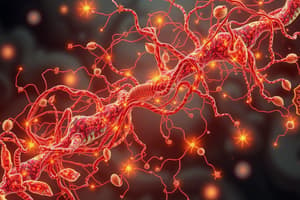Podcast
Questions and Answers
What is the definition of saltatory conduction?
What is the definition of saltatory conduction?
- Regeneration of action potential in all parts of the axon
- Propagation of action potential along myelinated axons from one node of Ranvier to the next (correct)
- Propagation of action potential along unmyelinated axons
- It refers to the speed of sodium ions entering the axon
What are the nodes of Ranvier?
What are the nodes of Ranvier?
Uninsulated areas on the axon where ions are exchanged across the axon membrane.
What is the function of the myelin sheath?
What is the function of the myelin sheath?
Increases the speed of nerve impulse and reduces energy loss.
What direction does orthodromic conduction occur?
What direction does orthodromic conduction occur?
What direction does antidromic conduction occur?
What direction does antidromic conduction occur?
In what area is the action potential created after a neuron is stimulated?
In what area is the action potential created after a neuron is stimulated?
What are the steps in conduction along a neuron?
What are the steps in conduction along a neuron?
What is a synapse?
What is a synapse?
What type of synapse is faster?
What type of synapse is faster?
What happens at a chemical synapse when an action potential reaches the axon end?
What happens at a chemical synapse when an action potential reaches the axon end?
What are examples of neurotransmitters?
What are examples of neurotransmitters?
What are the two types of receptors?
What are the two types of receptors?
Study Notes
Saltatory Conduction
- Saltatory conduction is the process through which action potentials travel along myelinated axons by jumping from one node of Ranvier to the next.
- This mechanism significantly increases the conduction velocity and allows long-distance electrical signal transmission without signal degradation.
Nodes of Ranvier
- Nodes of Ranvier are uninsulated segments along the axon that facilitate ion exchange across the axon membrane.
- Sodium influx at these nodes triggers an electrical force that helps propagate the action potential to the next node, ensuring rapid conduction.
Myelin Sheath Function
- The myelin sheath enhances the speed of nerve impulse transmission.
- It minimizes energy loss by reducing the frequency of sodium and potassium ion exchanges needed to return the axon to resting potential.
Types of Conduction
- Orthodromic conduction refers to the direction of action potential traveling from the nucleus to the axon terminal.
- Antidromic conduction is the reverse, moving from the axon terminal back to the nucleus.
Action Potential Generation
- The action potential is initiated at the axon hillock, located at the junction between the soma (cell body) and the axon.
Nerve Impulse Conduction
- A nerve impulse is triggered by stimulation, propagating from the dendrites through the neuron to the axon.
- Depolarization of adjacent areas along the axon generates new action potentials, continuing the signal.
Synapses
- Synapses are junctions for transmitting nerve impulses to target cells, which can be neurons or muscle cells.
- There are two main types of synapses: electrical synapses (direct, fast communication) and chemical synapses (involving neurotransmitter release).
Electrical Synapse
- Electrical synapses are characterized by their bidirectionality and rapid transmission, involving direct cytoplasmic connections through gap junctions.
Chemical Synapse
- Chemical synapses are more common and unidirectional; they require neurotransmitter release from synaptic vesicles.
- Upon reaching the axon terminal, action potentials open voltage-gated Ca2+ channels, leading to the influx of Ca2+ that prompts neurotransmitter exocytosis.
Neurotransmitters
- Various types of neurotransmitters include:
- Amino acids: Glycine, GABA, Glutamate, Aspartate
- Peptides: Vasopressin, Somatostatin, Neurotensin
- Monoamines: Norepinephrine, Dopamine, Serotonin, Acetylcholine
Receptors
- Receptors for neurotransmitters are categorized into:
- Ionotropic receptors: These are ligand-gated ion channels that open in response to neurotransmitter binding.
- Metabotropic receptors: These are activated by ligand binding and initiate metabolic changes within the cell.
Studying That Suits You
Use AI to generate personalized quizzes and flashcards to suit your learning preferences.
Description
Explore the essential concepts of saltatory conduction through these informative flashcards. Learn how action potentials propagate along myelinated axons and the significance of the Nodes of Ranvier in nerve signal transmission. Perfect for neuroscience students and enthusiasts!




